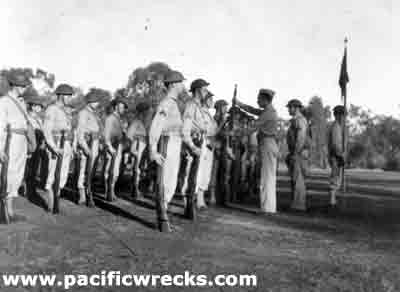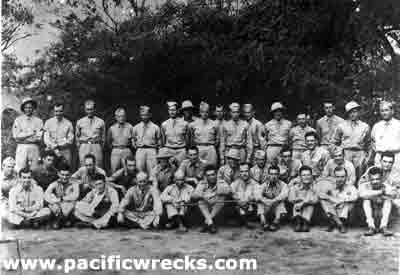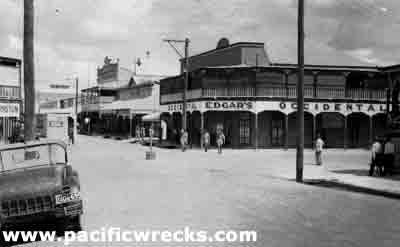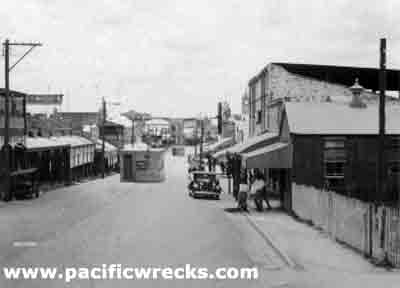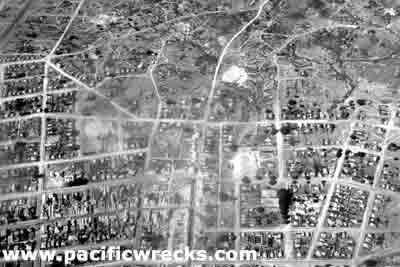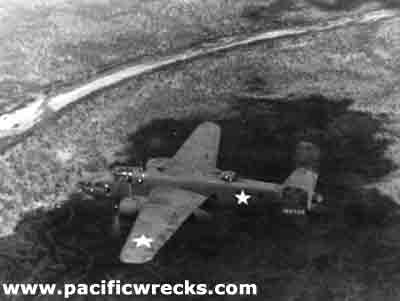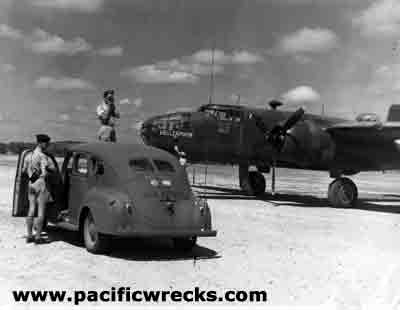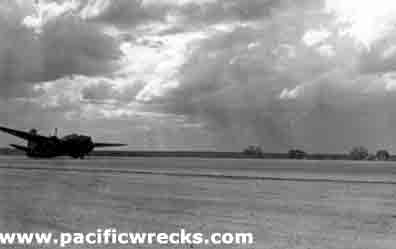|
Charters Towers was a small town about 90 miles inland from the port city of Townsville in N.E. Queensland. In its hayday early on it had been a booming gold mining town. Apparently the gold had long since played out. In the 10 months the 3rd Bomb. Gp. was based there we succeeded in filling three mine shafts with our garbage. I was once on the garbage detail and it was a bit scarey to back up to that open mine shaft with no rails or fences around it to dump the garbage in. The town sort of reminded one of the old Western towns in the U.S. that we used to see in the cowboy movies we went to when we were kids. A lot of the bldgs. had wooden structues out over the sidewalks. At this latitude you are getting close to tropical country and the sun does get hot during the day. On the other hand in their winter, June, July and Aug. a couple army blankets were nice to have handy at nite. One thing we never saw in the movies was the little concrete block houses in the middle of the streets about every block. We soon learned that these were the bomb shelters. The town lucked out and never did have any raids. Townsville had some alerts, but I don't recall that they were ever bombed. Darwin in the N.E. corner did have some air raids. Another oddity that we didn't see back in the States were automobiles that were powered by some kind of gas or by charcoal. The ones that used the gas had big rubber bags on the roofs, the width and lenghth of the auto. This would be filled with gas and that is what the auto ran on. The charcoal burners had a contraption on the rear bumper that looked like a couple of small barrels side by side. These burned charcoal which somehow powered the automobile. Never did know how the things worked, whether it was the carbon dioxide from the burning or what. Not being mechanically inclined, it was an oddity that really didn't interest me. The town had its share of Pubs and restaurants and two movie houses - and that is using the term "house" loosely. The movies were roofless, and the seats were canvas lawn chairs.. In the advent of rain - movie canceled - but that didn't happen too frequently, as rain was another oddity. Out at the base at one point our tent was right on the bank of a dry creek bed. Never did see any water in that creek. I did make several trips into town to go to movies. Special Services hadn't got into the act yet and provided movies for the outfits. That came later in New Guinea. Don't recall that I ever visited any of the restaurants. But there was a bakery in town where you could buy sweet rolls and meat pies. There was a back road, ungaurded, that we used to use on occasion. If we had a particularly bad meal at nite, we used to slip off the base and bring back something from the bakery. For me the Pubs were off limits, as I hadn't got into doing much drinking at this point in my life. I turned my 19th birthday two days after we arrived at the base. They didn't card the Am. G.I.s, but I just didn't have any inclination to visit the Pubs. The best friend I acquired in the service was a year older, and he had a taste for Calverts and Coke (or any reasonable facimili). He visited the Pubs rather frequently, and more than once I put him to bed as he came staggering home at nite. The officers had their own private club at 26 Aland St. called the "The Third Slug". Being a lowly Cpl. and not having got into photography at this point I never saw the inside of the place. Later on in New Guinea I visited their clubs several times with my camera to photograph (official?) affairs. In February they started a crash project to build
airstrips near the town. My outfit, the Thrid Bomb. Gp. (L) had
arrived in Brisbane aboard the U.S.S. Ancon on Feb. 25, 1942. March
10th after a three day trip on a rather antiquated cinder burner
we arrived at Charters Towers with all of our equipment -- everything
except aircraft and senior officers. When we left Savannah, Ga.
they kept our aircraft to pull submarine patrol and all of our senior
officers, and some high ranking enlisted men to form a new Group.
That Group proved to the be the 312th, which would wind up in the
S.W.P.A. sometime in 1943. In the mean time we arrived at Charters
Towers with a 1st Lt. as Gp. Commander and no aircraft. March 10, 1942 the 3rd Bomb. Gp. arrived at the newly constructed air strips sans aircraft and high ranking officers. After getting the camp set up and approriate slit trenches dug, to fill in our time we did a little infantry type training, of which most of us had had very little of. The interesting part of it is the fact you know it was early in the war. We were wearing the old steel helmet. The new style would come later. During the month of March we would recieve 42 officers and 64 enlisted men from the 27th Bomb Gp. which was caught in the Phillipines without their aircraft. Also recieved 24 A-24 Douglas Dauntless dive bombers. The 27th pilots had picked them up in Brisbane, but never got any closer to the P.I. than Java. They were pulled back and assigned to the 8th Sq. in our outfit. Included in the officers were their Commanding Officer, Col. John Davies who was given command of the Third, and Capt. P.I. Pappy Gunn. An old retired Navy flyer who had been working with an Airlines in the P.I. and commisioned a Capt and taken into the Air Force. He would be instrrumental in converting both the B-25 and A-20 into low level straffing attack planes. All of the preliminary expierimenting and testing was done at the base in C.T. The actual conversions were done in Brisbane. Col. Davies had got word that there were 25 B-25s in Brisbane that belonged to the Dutch, but the Dutch had no pilots to fly them. Davies took a group of pilots to Brisbane and they came back with the B-25s, and half were assigned to the 13th Sq. and half to the 90th Sq. After 60 years, I'm still not sure whether those planes came to us legally or whether we stole them. There seem to be good arguments for both cases. At any rate we made good use of them. On April 1, 1942 we pulled our lst combat mission of WW II with the A-24s after having flown to Port Moesby, New Guinea to gas up and bomb up. They returned to Moreseby, gased up and returned to C.T. On April 5 (Easter Sunday) the 13th & 90th pulled their first mission of the war with their B-25s, the mission being to Gasmata. Following the same routine; fly to Moresby, gas up, bomb up, fly the mission; return to Moresby to gas up and fly back to C.T. Early in the war Port Moresby was a hot target for Jap Betty Bombers and it was not safe to hang around too long. We followed that proceedure for the 10 months that we remained at C.T. About the last couple months we had gained enough control of the air over Moresby, that two Sqs. would fly up, stay two weeks, and be rotated by the other two Sqs. In July the 8th Sq. had lost all of the A-24s,
as they were sorely outclassed by the Zero. The 89th had been getting
what A-20s that had been coming in, and the 8th was getting B-25s
as we could get them. That is the way we operated until Jan. 1944,
when we finally got a full compliment of 80 A-20s, 20 per Sq. On
April 7, '42 Col. Davies led 10 of the 13th and 90th B-25's to Darwin.
There they installed bombbay tanks and were joined by Gen Royce
and 3 B-17s. They flew non-stop to Del Monte on Mindanao in the
P.I. Operating out of secret bases for four days they hit shipping
and installations in the Cebu. Davao and Mindanao areas. After 4
days the Japs discovered where they were coming from and all 13
planes returned with no loss of life. It was more or less a token
mission, but did an awful lot to raise morale in our The first year of the war was very costly to our Gp. in both men and aircraft. On one mission to Lae we sent 6 B-25s out and got one back. It was not unusual to lose 2 or 3 planes on a mission that didn't include but about 6 to 9 air craft. There were times when we could only put a half dozen planes in the air for a mission Will send photos of B-25s waiting and taking off from C.T. strip for a mission. Also during this time we were woefully short of combat crews, and had a number of RAAF pilots flying with us. Will send a photo of Maj. A. Evanoff (the Mad Russian) 13th Sq. Commander taking movies of a line up of 13th B-25s with W.O. Soundy looking on. Soundy later was lost on "Not in Stock" when it went down. We lost quite a few of the Aussies on missions. During the time at C.T. we were constantly getting replacement combat crews and this required some local training missions. On one of these I caught a photo of "8-ball Esquire" flying over the Burdiken River near C.T. In Oct. of '42 Maj. Evanoff lined up all 13 of the 13th Sq. planes and crews (both combat and ground) and we photographed each one and got some long shots. Will include Maj. Evanoff's crew, which includes Col. Davies, the tall fellow on the right end. By January 1943 we packed up and moved to Port Moresby. After that the C.T. base saw very little use as the war moved on up the north side of New Guinea and onto the Philippines. Will include a shot of a break on the truck convoy to Townsville where we loaded onto a tramp steamer and headed for that Beautiful Tropical Resort City of Port Moresby. And if you believe that I know of some swamp land in Florida you can buy. They didn't call New Guinea the "Green Hell" for nothing. |
|
Return to Jack Heyn Main Page
